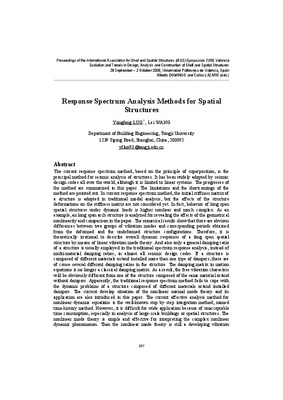JavaScript is disabled for your browser. Some features of this site may not work without it.
Buscar en RiuNet
Listar
Mi cuenta
Estadísticas
Ayuda RiuNet
Admin. UPV
Response Spectrum Analysis Methods for Spatial Structures
Mostrar el registro sencillo del ítem
Ficheros en el ítem
| dc.contributor.author | LUO, Yongfeng
|
|
| dc.contributor.author | WANG, Lei
|
|
| dc.contributor.editor | Domingo Cabo, Alberto
|
es_ES |
| dc.contributor.editor | Lázaro Fernández, Carlos Manuel
|
es_ES |
| dc.date.accessioned | 2009-12-01T08:21:57Z | |
| dc.date.available | 2009-12-01T08:21:57Z | |
| dc.date.issued | 2009-12-01T08:21:57Z | |
| dc.identifier.isbn | 978-84-8363-461-5 | |
| dc.identifier.uri | http://hdl.handle.net/10251/6532 | |
| dc.description | p. 397-408 | en_EN |
| dc.description.abstract | The current response spectrum method, based on the principle of superposition, is the principal method for seismic analysis of structures. It has been widely adopted by seismic design codes all over the world, although it is limited to linear systems. The progresses of the method are summarized in this paper. The limitations and the shortcomings of the method are pointed out. In current response spectrum method, the initial stiffness matrix of a structure is adopted in traditional modal analysis, but the effects of the structure deformations on the stiffness matrix are not considered yet. In fact, behavior of long span spatial structures under dynamic loads is higher nonliear and much complex. As an example, an long span arch structure is analyzed for revealing the effects of the geometrical nonlinearity and comparison in the paper. The numerical results show that there are obvious differences between two groups of vibration modes and corresponding periods obtained from the deformed and the undeformed structure configurations. Therefore, it is theoretically irrational to describe overall dynamic responses of a long span spatial structure by means of linear vibration mode theory. And also only a general damping ratio of a structure is usually employed in the troditional spectrum response analysis, instead of multi-material damping ratios, in almost all seismic design codes. If a structure is composed of different materials or/and installed more than one type of dampers, there are of couse several different damping ratios in the structure. The damping matrix in motion equations is no longer a classical damping matrix. As a result, the free vibration characters will be obviously different from one of the structure composed of the same material or/and without dampers. Apparently, the traditional response spectrum method fails to cope with the dynamic problems of a structure composed of different materials or/and installed dampers. The current develop situation of the nonlinear normal mode theory and its application are also introduced in this paper. The current effective analysis method for nonlinear dynamic equations is the well-known step by step integration method, named time-history method. However, it is difficult for wide application because of unacceptable time consumption, especially in analysis of large-scale buildings or spatial structures. The nonlinear mode theory is simple and effective for interpreting the complex nonlinear dynamic phenomenon. Then the nonlinear mode theory is still a developing vibration theory now. Few references about it can be found nowadays. If the nonlinear normal mode theory is adopted trying to solve the nonlinear structural dynamic problems, one of the crucial technique is to solve the geometrical nonlinear eigen equations. Futher investigation about an improved theoretical method for analysis of geometrical nonlinear dynamic behavior of long span spatial structures has been conducted now. The nonlinear mode theory and the response spectrum method are combined in the improved method. The research focus on 5 main steps. A future research frame of the method is introduced briefly. | en_EN |
| dc.language | Inglés | en_EN |
| dc.publisher | Editorial Universitat Politècnica de València | es_ES |
| dc.relation.ispartof | Symposium of the International Association for Shell and Spatial Structures (50th. 2009. Valencia). Evolution and Trends in Design, Analysis and Construction of Shell and Spatial Structures : Proceedings | en_EN |
| dc.rights | Reserva de todos los derechos | en_EN |
| dc.subject | Response-spectrum method | en_EN |
| dc.subject | Nonlinear normal modes | en_EN |
| dc.subject | Geometrical nonlinerity | en_EN |
| dc.subject | Long span spatial structures | en_EN |
| dc.title | Response Spectrum Analysis Methods for Spatial Structures | en_EN |
| dc.type | Comunicación en congreso | en_EN |
| dc.rights.accessRights | Abierto | es_ES |
| dc.description.bibliographicCitation | Luo, Y.; Wang, L. (2009). Response Spectrum Analysis Methods for Spatial Structures. Editorial Universitat Politècnica de València. http://hdl.handle.net/10251/6532 | es_ES |
| dc.relation.conferencename | Symposium of the International Association for Shell and Spatial Structures | es_ES |
| dc.relation.conferencedate | 2009 | es_ES |
| dc.relation.conferenceplace | Valencia | es_ES |






